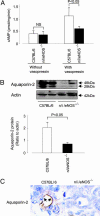Nephrogenic diabetes insipidus in mice lacking all nitric oxide synthase isoforms
- PMID: 16024729
- PMCID: PMC1175830
- DOI: 10.1073/pnas.0502236102
Nephrogenic diabetes insipidus in mice lacking all nitric oxide synthase isoforms
Abstract
Nitric oxide (NO) is produced in almost all tissues and organs, exerting a variety of biological actions under physiological and pathological conditions. NO is synthesized by three different isoforms of NO synthase (NOS), including neuronal, inducible, and endothelial NOSs. Because there are substantial compensatory interactions among the NOS isoforms, the ultimate roles of endogenous NO in our body still remain to be fully elucidated. Here, we have successfully developed mice in which all three NOS genes are completely deleted by crossbreeding singly NOS-/- mice. NOS expression and activities were totally absent in the triply NOS-/- mice before and after treatment with lipopolysaccharide. Although the triply NOS-/- mice were viable and appeared normal, their survival and fertility rates were markedly reduced as compared with the wild-type mice. Furthermore, these mice exhibited marked hypotonic polyuria, polydipsia, and renal unresponsiveness to an antidiuretic hormone, vasopressin, all of which are characteristics consistent with nephrogenic diabetes insipidus. In the kidney of the triply NOS-/- mice, vasopressin-induced cAMP production and membranous aquaporin-2 water channel expression were reduced associated with tubuloglomerular lesion formation. These results provide evidence that the NOS system plays a critical role in maintaining homeostasis, especially in the kidney.
Figures





Similar articles
-
Development of genetically engineered mice lacking all three nitric oxide synthases.J Pharmacol Sci. 2006 Oct;102(2):147-54. doi: 10.1254/jphs.cpj06015x. Epub 2006 Oct 7. J Pharmacol Sci. 2006. PMID: 17031076 Review.
-
[Development of genetically engineered mice lacking all three nitric oxide synthase isoforms].Yakugaku Zasshi. 2007 Sep;127(9):1347-55. doi: 10.1248/yakushi.127.1347. Yakugaku Zasshi. 2007. PMID: 17827917 Review. Japanese.
-
Pathophysiological relevance of NO signaling in the cardiovascular system: novel insight from mice lacking all NO synthases.Pharmacol Ther. 2010 Dec;128(3):499-508. doi: 10.1016/j.pharmthera.2010.08.010. Epub 2010 Sep 6. Pharmacol Ther. 2010. PMID: 20826180 Review.
-
Spontaneous myocardial infarction in mice lacking all nitric oxide synthase isoforms.Circulation. 2008 Apr 29;117(17):2211-23. doi: 10.1161/CIRCULATIONAHA.107.742692. Epub 2008 Apr 14. Circulation. 2008. PMID: 18413498
-
Genetic disruption of all NO synthase isoforms enhances BMD and bone turnover in mice in vivo: involvement of the renin-angiotensin system.J Bone Miner Res. 2008 May;23(5):633-43. doi: 10.1359/jbmr.080107. J Bone Miner Res. 2008. PMID: 18433298
Cited by
-
Decreased Bronchial Eosinophilic Inflammation and Mucus Hypersecretion in Asthmatic Mice Lacking All Nitric Oxide Synthase Isoforms.Lung. 2016 Feb;194(1):121-4. doi: 10.1007/s00408-015-9833-4. Epub 2015 Dec 19. Lung. 2016. PMID: 26685897
-
Birth elicits a conserved neuroendocrine response with implications for perinatal osmoregulation and neuronal cell death.Sci Rep. 2021 Jan 27;11(1):2335. doi: 10.1038/s41598-021-81511-1. Sci Rep. 2021. PMID: 33504846 Free PMC article.
-
Aquaporin-2 promoter is synergistically regulated by nitric oxide and nuclear factor of activated T cells.Nephron Extra. 2011 Jan;1(1):124-38. doi: 10.1159/000333066. Epub 2011 Oct 22. Nephron Extra. 2011. PMID: 22470386 Free PMC article.
-
NOS isoform-specific regulation of basal but not exercise-induced mitochondrial biogenesis in mouse skeletal muscle.J Physiol. 2007 Nov 15;585(Pt 1):253-62. doi: 10.1113/jphysiol.2007.141309. Epub 2007 Oct 4. J Physiol. 2007. PMID: 17916611 Free PMC article.
-
Role of nitric oxide signaling in endothelial differentiation of embryonic stem cells.Stem Cells Dev. 2010 Oct;19(10):1617-26. doi: 10.1089/scd.2009.0417. Stem Cells Dev. 2010. PMID: 20064011 Free PMC article.
References
-
- Moncada, S., Palmer, R. M. J. & Higgs, E. A. (1991) Pharmacol. Rev. 43, 109-142. - PubMed
-
- Furchgott, R. F. (1984) Annu. Rev. Pharmacol. Toxicol. 24, 175-197. - PubMed
-
- Ignarro, L. J. (1990) Annu. Rev. Pharmacol. Toxicol. 30, 535-560. - PubMed
-
- Murad, F. (1997) Circulation 95, 1101-1103. - PubMed
-
- Bredt, D. S. & Snyder, S. H. (1994) Annu. Rev. Biochem. 63, 175-195. - PubMed
Publication types
MeSH terms
Substances
LinkOut - more resources
Full Text Sources
Other Literature Sources
Molecular Biology Databases

